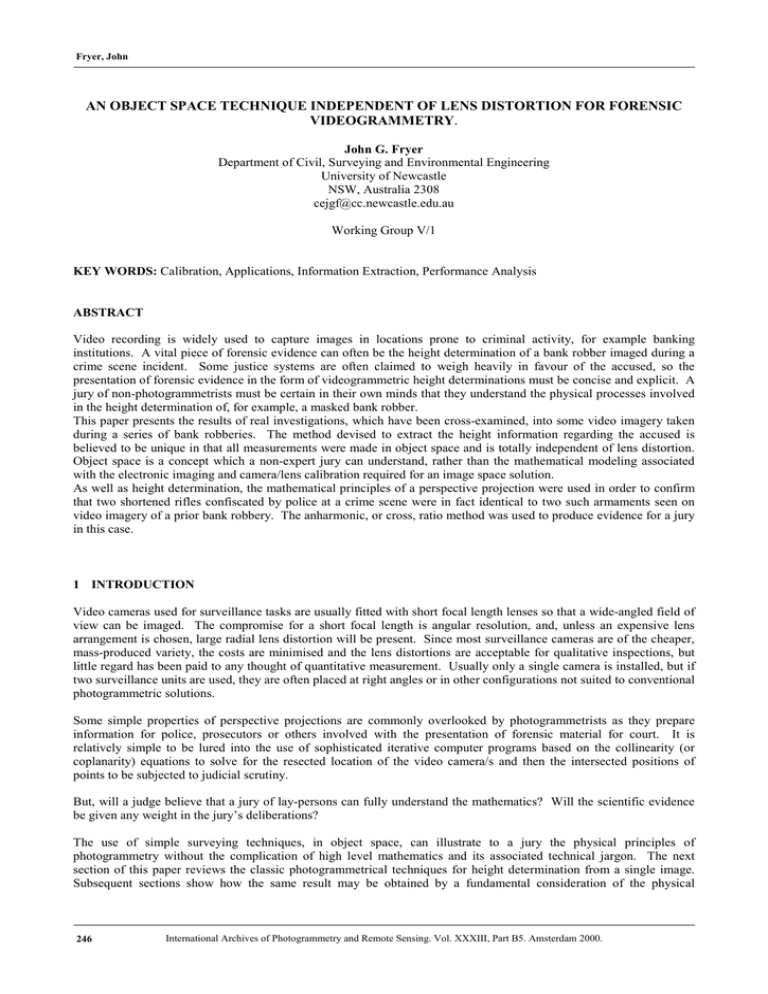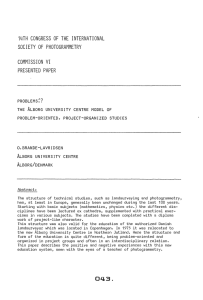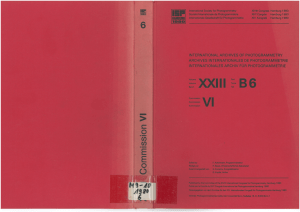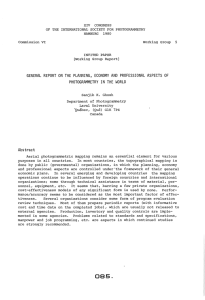AN OBJECT SPACE TECHNIQUE INDEPENDENT OF LENS DISTORTION FOR FORENSIC VIDEOGRAMMETRY
advertisement

Fryer, John AN OBJECT SPACE TECHNIQUE INDEPENDENT OF LENS DISTORTION FOR FORENSIC VIDEOGRAMMETRY. John G. Fryer Department of Civil, Surveying and Environmental Engineering University of Newcastle NSW, Australia 2308 cejgf@cc.newcastle.edu.au Working Group V/1 KEY WORDS: Calibration, Applications, Information Extraction, Performance Analysis ABSTRACT Video recording is widely used to capture images in locations prone to criminal activity, for example banking institutions. A vital piece of forensic evidence can often be the height determination of a bank robber imaged during a crime scene incident. Some justice systems are often claimed to weigh heavily in favour of the accused, so the presentation of forensic evidence in the form of videogrammetric height determinations must be concise and explicit. A jury of non-photogrammetrists must be certain in their own minds that they understand the physical processes involved in the height determination of, for example, a masked bank robber. This paper presents the results of real investigations, which have been cross-examined, into some video imagery taken during a series of bank robberies. The method devised to extract the height information regarding the accused is believed to be unique in that all measurements were made in object space and is totally independent of lens distortion. Object space is a concept which a non-expert jury can understand, rather than the mathematical modeling associated with the electronic imaging and camera/lens calibration required for an image space solution. As well as height determination, the mathematical principles of a perspective projection were used in order to confirm that two shortened rifles confiscated by police at a crime scene were in fact identical to two such armaments seen on video imagery of a prior bank robbery. The anharmonic, or cross, ratio method was used to produce evidence for a jury in this case. 1 INTRODUCTION Video cameras used for surveillance tasks are usually fitted with short focal length lenses so that a wide-angled field of view can be imaged. The compromise for a short focal length is angular resolution, and, unless an expensive lens arrangement is chosen, large radial lens distortion will be present. Since most surveillance cameras are of the cheaper, mass-produced variety, the costs are minimised and the lens distortions are acceptable for qualitative inspections, but little regard has been paid to any thought of quantitative measurement. Usually only a single camera is installed, but if two surveillance units are used, they are often placed at right angles or in other configurations not suited to conventional photogrammetric solutions. Some simple properties of perspective projections are commonly overlooked by photogrammetrists as they prepare information for police, prosecutors or others involved with the presentation of forensic material for court. It is relatively simple to be lured into the use of sophisticated iterative computer programs based on the collinearity (or coplanarity) equations to solve for the resected location of the video camera/s and then the intersected positions of points to be subjected to judicial scrutiny. But, will a judge believe that a jury of lay-persons can fully understand the mathematics? Will the scientific evidence be given any weight in the jury’s deliberations? The use of simple surveying techniques, in object space, can illustrate to a jury the physical principles of photogrammetry without the complication of high level mathematics and its associated technical jargon. The next section of this paper reviews the classic photogrammetrical techniques for height determination from a single image. Subsequent sections show how the same result may be obtained by a fundamental consideration of the physical 246 International Archives of Photogrammetry and Remote Sensing. Vol. XXXIII, Part B5. Amsterdam 2000. Fryer, John processes involved. These processes, such as demonstrable ray tracing in object space, provide strong visual evidence to a court in a manner comprehensible to a lay-person on a jury. 2 HEIGHT DETERMINATION - TRADITIONAL PHOTOGRAMMETRY A scene captured from a video surveillance camera is shown as Figure 1. Surveillance cameras typically record at about two frames per second, so if a “normal” bank robbery is of 40 - 60 seconds duration, approximately 80 to 120 images will be available for forensic investigation. It is most probable that in at least a few of these frames, the robber/s will be reasonably upright and standing in front of some permanent fixtures which can be used in the height determination process. For example, a consideration of Figure 1 shows a robber waiting for some money in front of the teller’s grille, with the top of his head coincident with that grille and the location of his feet in identifiable positions on a patterned carpet. Most bank robbers are aware of the video surveillance cameras and wear masks or balaclavas to conceal their facial identification. The height of the bank robber cannot be so easily concealed and this is one piece of physical evidence which photogrammetrists can be called upon to provide to the court. The traditional photogrammetric method for obtaining the height of an object in a single image involves: ! obtaining the original video tape or at least a good copy. This should always be attempted, but it may not be possible as some well-meaning policeman or lawyer may have had prints produced from the tape and it will be “lost”. These prints may be cropped in an unknown manner, adding to the skills required of the photogrammetrist. ! a physical survey of the position of the surveillance camera in relation to some fixtures seen in the image. Usually tape and plumb-bob will suffice for the survey which sets up a local coordinate system. Figure 1. Bank robber. Note patterned carpet and top of head aligned with light ray to top of teller’s grille. ! a determination of lens distortion and other camera parameters such as principal distance and offsets of the principal point. The radial lens distortion may be quite severe as usually a wide angled lens (short focal length) is chosen in order to provide for a wide field of view. ! a space resection to find the orientation and location of the perspective centre of the surveillance camera. ! the image measurement of the robber and then the solution to the problem as outlined in Figure 2, noting that the image coordinates of the head and feet must be corrected for offsets of the principal point and lens distortion. 3 TIME DELAYS An unfortunate fact of life is that the photogrammetrist is usually summoned to provide forensic evidence only well after the incident occurs. Two or more years later is probably commonplace. If the thieves had been caught quickly by the police, there would be no need for the photogrammetrist as items of clothing, masks, guns or other physical evidence would still be present and the proceeds from the robbery would have been recovered. As Thompson (1962, 432) once indicated, photogrammetry is often used only as a last resort, after simpler methods have not proved possible. The interior decor of banks often changes, much to the angst to the forensic photogrammetrist. Carpet wears out quickly in areas of high pedestrian traffic in front of the tellers’ area. After a robbery, it is not unusual to see the installation of security screens, new glass panels, etc. which destroy the background scene as it was at the time of the International Archives of Photogrammetry and Remote Sensing. Vol. XXXIII, Part B5. Amsterdam 2000. 247 Fryer, John robbery. Fortunately some structural features usually remain, often those cupboards, desks and other furniture used by bank staff. It is those features which the photogrammetrist must use in any reconstruction. The forensic photogrammetrists must be aware that the present day bank scene will probably have been altered from the time of the incident. It is important to contact the manager and ask, and record in the field book, details of what changes have been made as a defense attorney will certainly pose those questions in court. It is most important to check if the present surveillance camera is the same one which was there at the time of the robbery and if its position has ever been moved. Scientific evidence can be discredited easily if any flaw, or even if the hint of uncertainty, can be raised in court. Figure 2. Traditional Photogrammetric Technique for Height Determination. Tra itiona d ens l and Camera Cal brati on i Spac Rese e ionc L t T ll rðs e e Gril e l Physi al c Measurements Measure image Coordi at ns e (x, ) y Cal ul cte a he gh si t by photo. tec niqu h s e 4 OBJECT SPACE RECONSTRUCTION Given the likely time delays between an incident and the involvement of the forensic photogrammetrist, it is strongly suggested that the photogrammetrist think and act in a more innovative manner than merely follow the traditional resection/intersection procedure outlined above. The time honoured technique outlined above (Figure 2) may prove to be the only possible solution to a given set of circumstances. Working in image space, however, when many uncertainties of camera calibration are present, really only provides ‘ammunition’ for the defense attorney when cross examination of the evidence takes place in court. The concept of object space reconstruction outlined here is based on actual experiences in court room situations. The physical reconstruction of a single image is a concept which the jury of lay persons, and the judge, can understand and embrace. Figure 1 showed the extension of the ray of light which has come from the camera, across the top of the head of the robber, and onto a permanent fixture such as the teller’s grille. If a piece of string is held tautly between the grille and the camera, the actual ray of light at the time of the robbery can be physically recreated. This is most compelling evidence for a jury. Lens distortion and camera calibration are totally irrelevant to this ray of light. Even if a fish-eye lens were installed, this principle would hold true - the ray of light which just grazes the head of the robber as seen on the image could be faithfully reproduced in object space. The location of the position of the robber’s feet in object space is the final consideration. Experience has indicated that this is probably achievable within 1 or 2 cm if a patterned carpet is present, otherwise approximately 10 - 15 cm can be expected if the robber is reasonably close (within a metre say) to an upright fixture such as the wall in front of the teller. The next consideration of a photogrammetrist is the slope of the string. The author’s experiences have been of the order of 1:3 or 1:4, meaning that a 3 or 4 cm error in the position of the surveying staff held at the feet location will result in a height error of 1 cm. See Figures 3, 4 and 5 for examples of the method applied in practice to the image shown as 248 International Archives of Photogrammetry and Remote Sensing. Vol. XXXIII, Part B5. Amsterdam 2000. Fryer, John Figure 1. It is essential to photographically record the procedure as these have a very positive impact on the jury and give credence to the photogrammetrist’s testimony. Figures 3 and 4. String line replicates ray of light from camera to teller’s grille, note staff located on patterned carpet. Close-up of string-line onto teller’s grille. String Li e n From Camer a To De inab f e l Obje c t Hold sta f onf −footprintð an d re d aff hei o ht g Figure 5. String-line Technique to discover height of robber. Surveillance cameras are usually placed high on the walls of banks, presumably out of the way of casual interference by the public. If they were placed lower, say around 2 m above the ground level, then height determination calculations by this technique would be more accurate. The grazing ray across the head of a robber would then be close to horizontal, thereby making the exact location of the robber’s feet much less crucial. The photogrammetrist must brief his attorney that the height values he produces can only be thought of as a ‘lower limit’ for the height of the robber. If the robber is not standing fully erect, or has his legs apart when walking, then of course the determined height will be too small. The court (either the judge or prosecutor) usually asks for an estimate of how much should be added to the height determination in order to estimate the ‘true height’ of the robber. GuessInternational Archives of Photogrammetry and Remote Sensing. Vol. XXXIII, Part B5. Amsterdam 2000. 249 Fryer, John work on the part of the photogrammetrist must be avoided at all times as the cross examiner will quickly try to discredit any unscientific estimates. In the work this author has presented to courts, reconstruction of the stance of the robber was undertaken by carefully positioning the feet of an assistant, whose height was similar to that of the robber, and measuring (and photographing!) him in that stance. See Figure 6. This technique provided upward estimates of 3 - 5 cm for the court to consider in conjunction with the actual height determination of the robber at the time of image capture. 5 ERROR ESTIMATION Given the above simple physical method of height determination, which left the defense little room for questioning and the raising of doubts, the only area where the photogrammetrist should expect strong questioning will relate to the estimation of likely errors. Courts have been ready to accept that the mean of several height determinations should provide a better answer than just one determination from one frame. The photogrammetrist must behave like the scientist he is and honestly evaluate his work and place error bounds around his answer. It is pure folly to claim too high an accuracy for the purpose of self-promotion, as egos can easily come undone in the tense atmosphere of a court. The photogrammetrist must realise that while his professional colleagues are au fait with normal distribution theory, standard errors and the 99% confidence limit, the court will require something simpler. A simple + or - bound placed around the height determination is something acceptable to the court and whether it is at the one, two or three standard error level is something best left to the photogrammetrist to decide, based on the merits of each situation and the advice of his attorney. Figure 6. Estimating an allowance to be added to height for the stance of a suspect. Most lay-persons believe that a standard error is a an absolute bound of accuracy, rather than an indicator of precision. Care should be taken lest the photogrammetrist suddenly finds he must present what amounts to a statistics lecture to the court. Such a situation would probably confuse and weaken the findings. Error bounds placed at the 3-sigma or 99% confidence level are reasonably easy to defend under oath in the witness box. 6 THE ANHARMONIC RATIO A fundamental property of a perspective projection is the anharmonic ratio (sometimes known as the ‘cross ratio’ (for example see Wolf, 1983, 252 ). This ratio can be best described by consideration of Figure 7. The cross product of AC.BD divided by AD.BC remains invariant for a particular object through a perspective projection. In a recent court case involving the author as an expert witness, the objects in question were an M1 Carbine rifle and a Winchester pump-action shotgun. Both weapons had been shortened in both the barrel and the stock and were therefore distinctive but not necessarily unique. The guns, and the accused, had been seized by police at an incident (see Figure 8) which was quite separate to the bank robbery which occurred several months earlier and was under prosecution in the court. The defense attorney claimed that the weapons in the video scenes of the bank robbery were not the same as those confiscated by the police on the later occasion. These weapons would provide compelling circumstantial evidence that the person arrested by police for the latter offence was the gunman wearing the balaclava in the bank robbery (see Figures 9 and 10). Figure 8. Shotguns seized by police 250 International Archives of Photogrammetry and Remote Sensing. Vol. XXXIII, Part B5. Amsterdam 2000. Fryer, John Figure 7 Dimensional Analysis by Per pe s tive c . (Anh rmonic a tio) R a a b c d Ima g e Ima Pla g en Camer Le a n s A B OB EC J T C D Anha monic r Rati o Rati o= AC . BD BC . AD a =. cbd = C nsta o tn bc . a d International Archives of Photogrammetry and Remote Sensing. Vol. XXXIII, Part B5. Amsterdam 2000. 251 Fryer, John Figures 9 and 10. Typical Scene of Bank Robbers with Guns, Close-up of Shotgun. The anharmonic ratio was applied to measurements made on the guns, which had been tendered as exhibits to the court case, and on frames printed from the video images. The differences in values obtained for the anharmonic ratios were usually less than 1%. Given the relatively coarse nature of the measurements (paper prints of the video scenes, magnifying glass, plastic ruler and a tape measure), this was considered to be strong evidence that the weapons exhibited in court and those measured off the video were identical. After six hours of presentation of evidence, crossexamination and re-examination, both with and without the presence of the jury, all the photogrammetric evidence was accepted. 7 CONCLUSION Photogrammetric principles applied to the imagery captured by surveillance cameras can provide strong evidence which is acceptable in courts of criminal law. The photogrammetrist must be prepared to be flexible in his methods and presentation of results. Conventional mathematical techniques of solution, such as iterative least squares applied to linearised collinearity equations, can be difficult to concisely explain to a jury of lay-persons. Physical models must be created and simple diagrams prepared to convince the jury that they can comprehend the scientific logic and calculations. The concept that light travels in straight lines and that a piece of string can replicate a ray of light is an example of the type of simple modeling which the photogrammetrist must exploit. Estimates of error must also be capable of demonstrable substantiation, not just the submission to the court of the last page of a printout of a computer program. A photogrammetrist in court must be thoroughly conversant with his subject and understand the physical realities of whatever mathematics he uses. The subtleties of photogrammetry, the source of much pleasure to those working in this profession, should be avoided in the court-room. These finer points of photogrammetry will only provide the opposing attorney with material which can be used to confuse a jury and thereby undermine the photogrammetric evidence. Keep it simple! POSTSCRIPT It must be stressed that the photogrammetric measurements and height determinations were not the sole items of evidence provided in the two court cases referenced in this paper. In one case there were 45, and in the other 72, persons who tendered different forms of evidence to the juries. Many belonged to various police departments who had been involved with covert surveillance of suspects, phone-tapping and other information gathering tasks. In some ways this made the photogrammetric evidence more valuable as juries can sometimes be suspicious when all the evidence is provided by the police. Finally, after 3 weeks of trial in one case and 6 weeks in the other, the juries returned guilty verdicts. The judges decided upon sentences of 12 and 18 years, with 10 and 14 year non-parole periods respectively (Regina v. Hughes, 1999 and Regina v. Gallagher, 1999). REFERENCES Regina v. Gallagher, 1999, District Court at Sydney, Kinchington QC DCJ. Regina v. Hughes, 1999, District Court at Newcastle, Armitage QC DCJ. Thompson, E.H., 1962. Photogrammetry. The Royal Engineers Journal 76(4): 432-444 and re-printed in Photogrammetry and Surveying, A Selection of Papers by E.H. Thompson, 1910-1976, Photogrammetric Society, London, 1977, 242-254. Wolf, P.R., 1983 , Elements of Photogrammetry, Mc. Graw-Hill, 628pp. 252 International Archives of Photogrammetry and Remote Sensing. Vol. XXXIII, Part B5. Amsterdam 2000.





